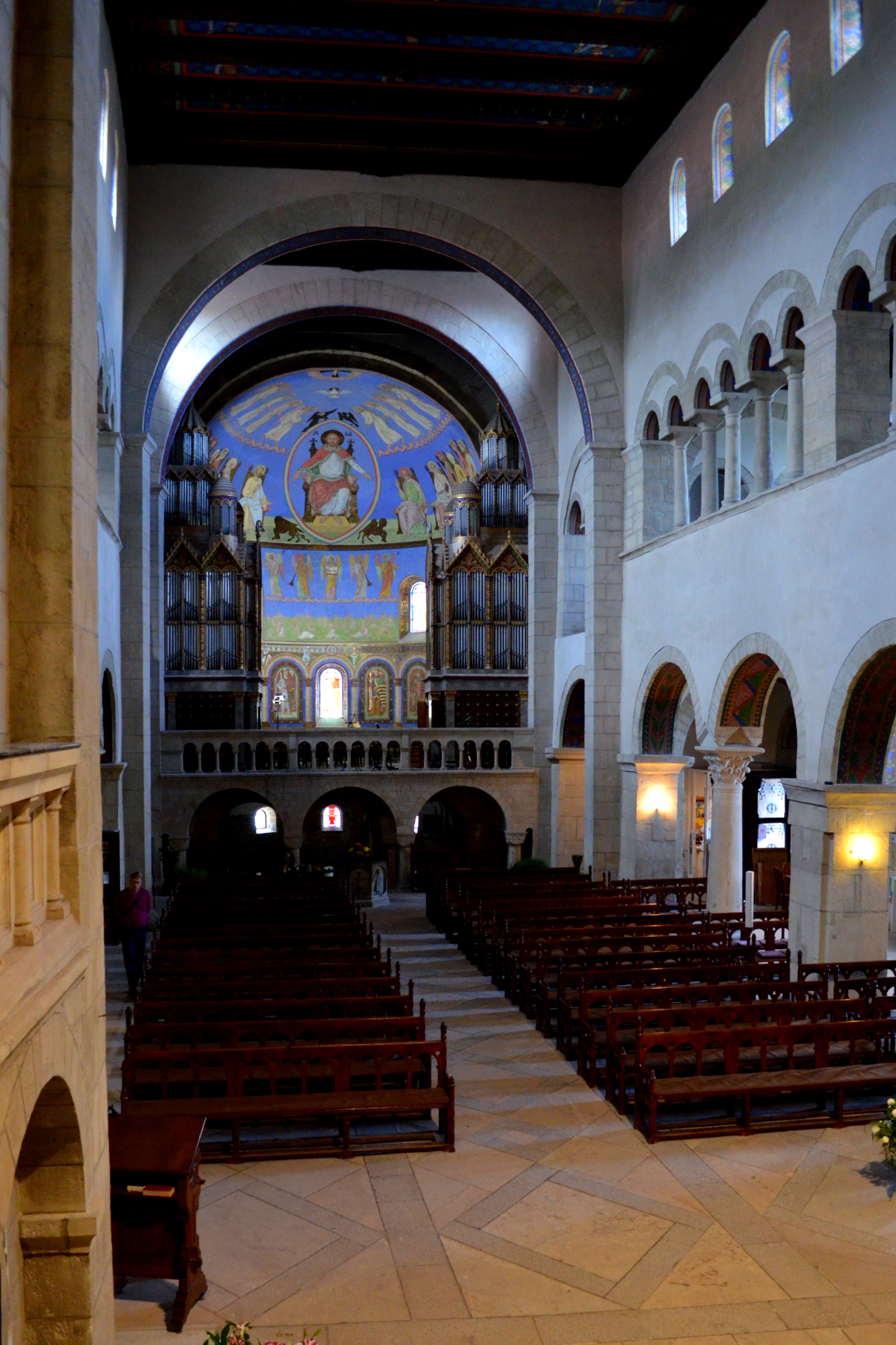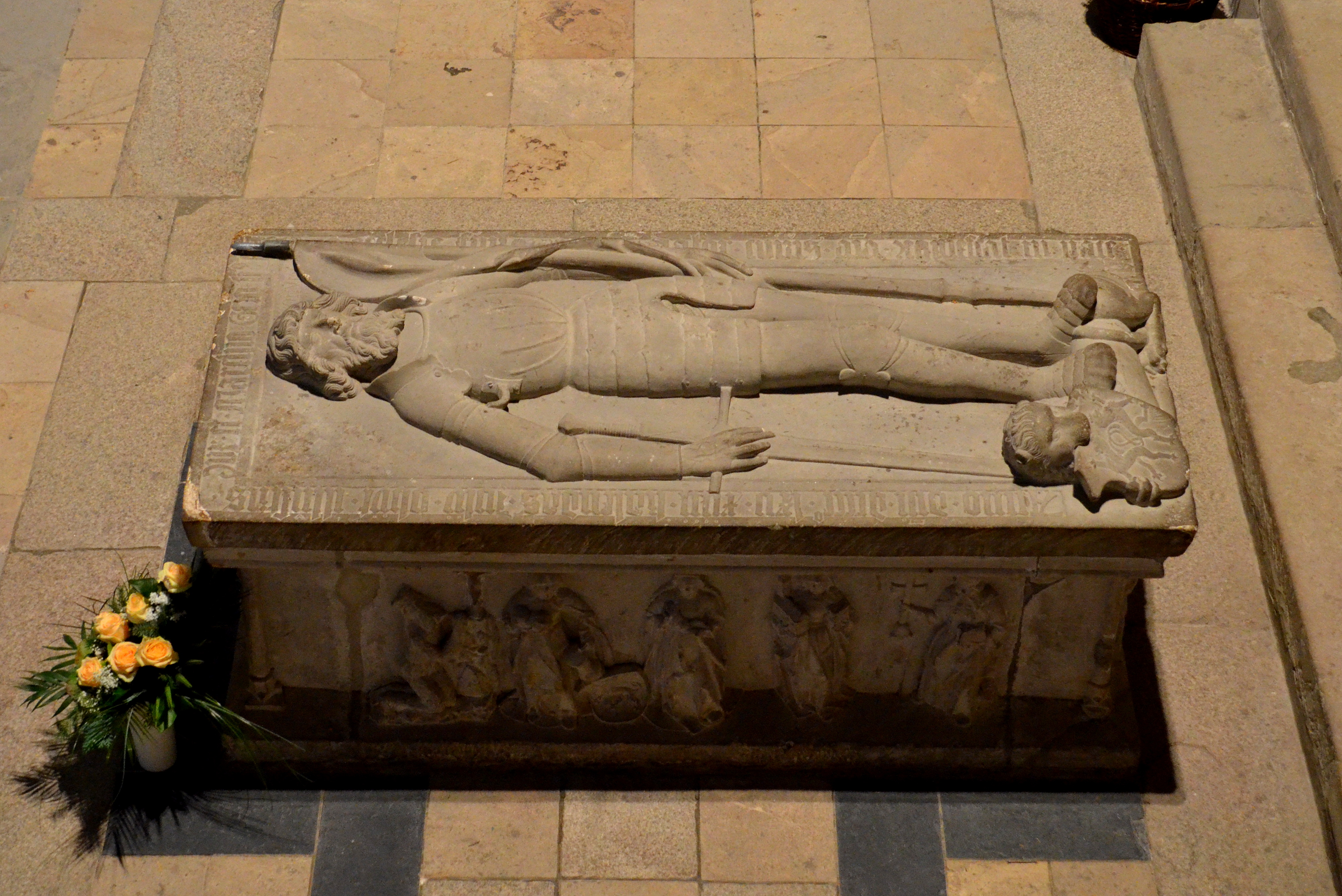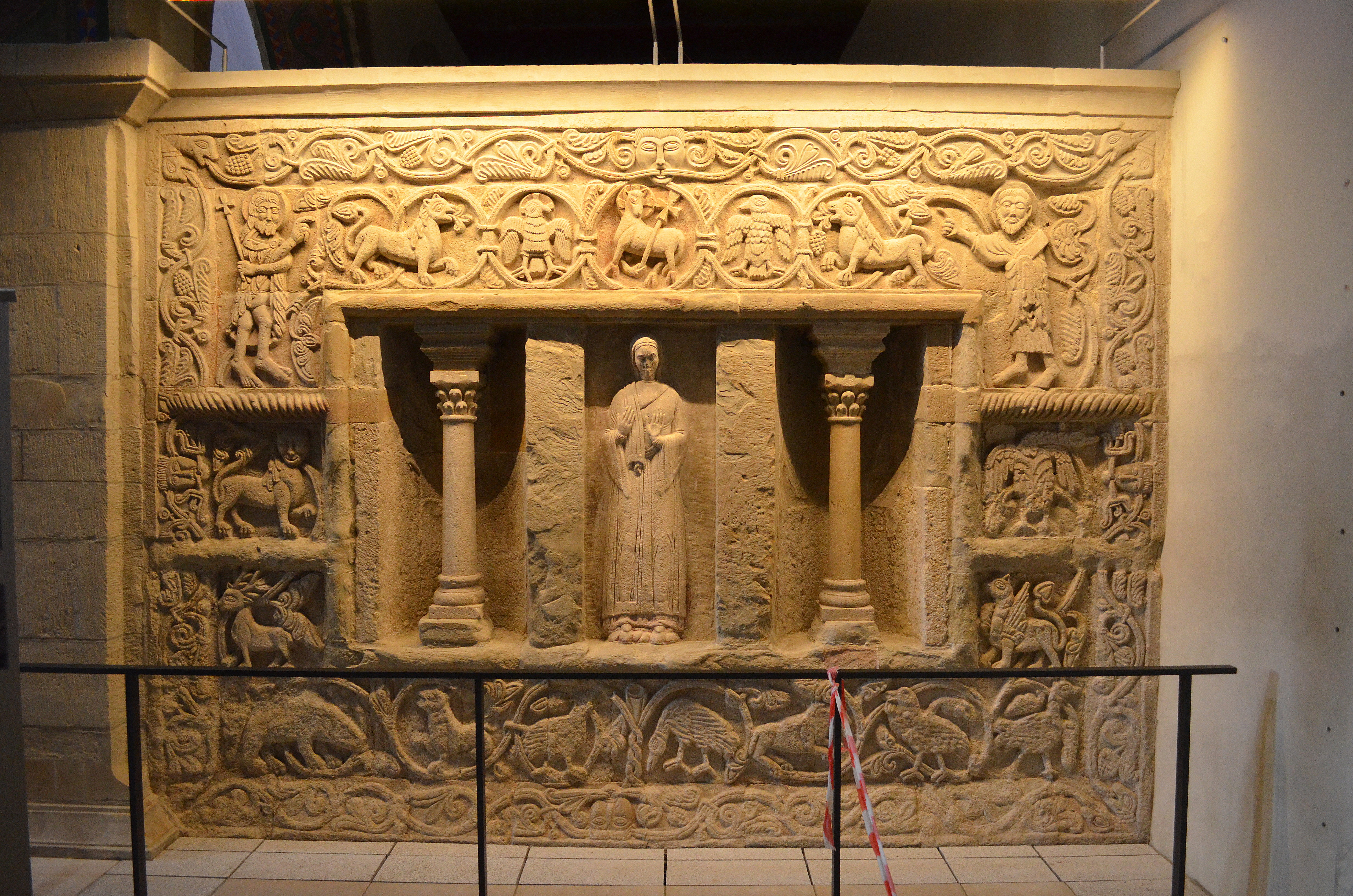Abbey Church Of Gernrode on:
[Wikipedia]
[Google]
[Amazon]
Saint Cyriakus (german: Stiftskirche St. Cyriakus, ) is a medieval church in

 In 999, Emperor
In 999, Emperor
 The tomb of Margrave Gero sits in the crossing before the steps to the choir. It is covered by a sandstone slab, carved into Gero's likeness, showing him in armor with sword and a flag. A lion is at his feet.
The tomb of Margrave Gero sits in the crossing before the steps to the choir. It is covered by a sandstone slab, carved into Gero's likeness, showing him in armor with sword and a flag. A lion is at his feet.
 The southern aisle houses a copy of the grave of Christ (a representation of the
The southern aisle houses a copy of the grave of Christ (a representation of the
Official website
Page at transromanica website
Website of ''Strasse der Romanik'' (tourist route)
{{DEFAULTSORT:Cyriakus, Gernrode Protestant churches in Saxony-Anhalt Buildings and structures in Harz (district) 10th-century churches in Germany Ottonian architecture Romanesque Road
Gernrode
Gernrode () is a historic town and former municipality in the Harz District, in Saxony-Anhalt, Germany. Since 1 January 2014, it has been part of Quedlinburg.Saxony-Anhalt
Saxony-Anhalt (german: Sachsen-Anhalt ; nds, Sassen-Anholt) is a state of Germany, bordering the states of Brandenburg, Saxony, Thuringia and Lower Saxony. It covers an area of
and has a population of 2.18 million inhabitants, making it the ...
, Germany. It is one of the few surviving examples of Ottonian architecture
Ottonian architecture is an architectural style which evolved during the reign of Emperor Otto the Great. The style was found in Germany and lasted from the mid 10th century until the mid 11th century.
History
Ottonian architecture draws its inspi ...
, built in 959/960–965 by Margrave Gero
Gero I ( – 20 May 965), sometimes called the Great ( la, magnus),Thompson, 486. Also se was a German nobleman who ruled an initially modest march centred on Merseburg in the south of the present German state of Saxony-Anhalt, which he expande ...
, although it was restored in the 19th century. From its foundation until 1614, Saint Cyriakus was the collegiate church In Christianity, a collegiate church is a church where the daily office of worship is maintained by a college of canons: a non-monastic or "secular" community of clergy, organised as a self-governing corporate body, which may be presided over by a ...
of the Abbey of Gernrode, also founded by Margrave Gero. The church and the abbey became Protestant
Protestantism is a Christian denomination, branch of Christianity that follows the theological tenets of the Reformation, Protestant Reformation, a movement that began seeking to reform the Catholic Church from within in the 16th century agai ...
in the mid-sixteenth century, and the church is now used by the Protestant community of Gernrode.
The church is part of the tourist route
A scenic route, tourist road, tourist route, tourist drive, holiday route, theme route, or scenic byway is a specially designated road or waterway that travels through an area of natural or cultural beauty. It often passes by scenic viewpoints ...
"Romanesque Road
The Romanesque Road (german: Straße der Romanik) is a scenic route in the German state of Saxony-Anhalt in central-east Germany. It is part of the Transromanica network, a major European Cultural Route since 2006.
Route
The route takes the ...
", as it is an important example of an Ottonian church which inspired later, fully Romanesque, churches and cathedrals.
History
Gero (d. 965) was a follower ofOtto I
Otto I (23 November 912 – 7 May 973), traditionally known as Otto the Great (german: Otto der Große, it, Ottone il Grande), was East Francia, East Frankish king from 936 and Holy Roman Emperor from 962 until his death in 973. He was the olde ...
from one of the most powerful families of eastern Saxony. In 937, Otto made Gero Margrave of the Eastern March. Gero, who owned a castle at Gernrode, decided to found a collegiate church In Christianity, a collegiate church is a church where the daily office of worship is maintained by a college of canons: a non-monastic or "secular" community of clergy, organised as a self-governing corporate body, which may be presided over by a ...
and female (lay) convent (''Stift'') here, in cooperation with his son Siegfried. Construction on the crypt, the eastern apse
In architecture, an apse (plural apses; from Latin 'arch, vault' from Ancient Greek 'arch'; sometimes written apsis, plural apsides) is a semicircular recess covered with a hemispherical vault or semi-dome, also known as an ''exedra''. In ...
and the convent started in 959. In 961, the foundation was awarded royal protection and in 963 the pope issued a privilege, which removed the convent from the influence of the Bishop of Halberstadt
The Diocese of Halberstadt was a Roman Catholic diocese (german: Bistum Halberstadt) from 804 until 1648.
. Siegfried had died heirless in 959. After Siegfried's death, his widow Hathui had become abbess of the convent. Gero returned from a trip to Rome with a valuable relic
In religion, a relic is an object or article of religious significance from the past. It usually consists of the physical remains of a saint or the personal effects of the saint or venerated person preserved for purposes of veneration as a tangi ...
of Saint Cyriacus
Cyriacus ( el, Ἅγιος Κυριακός, fl. 303 AD), sometimes Anglicized as Cyriac, according to Christian tradition, is a Christian martyr who was killed in the Diocletianic Persecution. He is one of twenty-seven saints, most of them mart ...
and the church was dedicated to this saint in 963. In 965, Gero died and was buried in front of the already finished eastern choir. A hiatus in construction followed Gero's death and is seen as the likely source of the shift in the church's axis - see map. Hathui ruled the convent for 55 years until her death in 1014.

 In 999, Emperor
In 999, Emperor Otto III
Otto III (June/July 980 – 23 January 1002) was Holy Roman Emperor from 996 until his death in 1002. A member of the Ottonian dynasty, Otto III was the only son of the Emperor Otto II and his wife Theophanu.
Otto III was crowned as King of ...
granted the convent Imperial status and in 1004, Empress Kunigunde Kunigunde, Kunigunda, or Cunigunde, is a European female name of German origin derived from "kuni" (clan, family) and "gund" (war). In Polish this is sometimes Kunegunda or Kinga. People with such names include:
* Kunigunde of Rapperswil (c. early ...
, wife of Emperor Heinrich II
Henry II may refer to:
Kings
*Henry II of England (1133–89), reigned from 1154
*Henry II of Jerusalem and Cyprus (1271–1324), reigned from 1285; king of Jerusalem in name only from 1291
*Henry II of Castile (1334–79), reigned 1366–67 and ...
visited the convent. The first stage of construction ended in 1014. That same year, on Hathui's death, Adelheid
Adelheid is the modern Dutch and German form of the Old High German female given name Adalheidis, meaning "nobility" or "noble-ness". It may refer to the following people:
* Saint Adelheid or Adelaide of Italy, (931–999), Holy Roman Empress an ...
, daughter of Emperor Otto II
Otto II (955 – 7 December 983), called the Red (''der Rote''), was Holy Roman Emperor from 973 until his death in 983. A member of the Ottonian dynasty, Otto II was the youngest and sole surviving son of Otto the Great and Adelaide of Italy. ...
succeeded her as abbess. Adelheid held that position until 1044.
Additions to the church in the 11th and 12th centuries include the west crypt
A crypt (from Latin ''crypta'' "vault") is a stone chamber beneath the floor of a church or other building. It typically contains coffins, sarcophagi, or religious relics.
Originally, crypts were typically found below the main apse of a chur ...
(first mentioned in 1149), side galleries, the enlargement of the westwork
A westwork (german: Westwerk), forepart, avant-corps or avancorpo is the monumental, often west-facing entrance section of a Carolingian, Ottonian, or Romanesque church. The exterior consists of multiple stories between two towers. The interior ...
(1127-1150) and the towers and the two-storey cloisters
A cloister (from Latin ''claustrum'', "enclosure") is a covered walk, open gallery, or open arcade running along the walls of buildings and forming a quadrangle or garth. The attachment of a cloister to a cathedral or church, commonly against a ...
(1170). In 1188, Emperor Friedrich I Barbarossa held court at Gernrode and gifted the "Barbarossa Bell" .
The vaults of the transept were added in the Gothic
Gothic or Gothics may refer to:
People and languages
*Goths or Gothic people, the ethnonym of a group of East Germanic tribes
**Gothic language, an extinct East Germanic language spoken by the Goths
**Crimean Gothic, the Gothic language spoken b ...
period.
The last Catholic abbess was Scholastika von Anhalt Dessau (1469-1504). Her successor, Elisabeth von Weida (1504–76) introduced Reformation
The Reformation (alternatively named the Protestant Reformation or the European Reformation) was a major movement within Western Christianity in 16th-century Europe that posed a religious and political challenge to the Catholic Church and in ...
in 1521. In 1525, Elisabeth managed to prevent damage to the convent during the German Peasants' War
The German Peasants' War, Great Peasants' War or Great Peasants' Revolt (german: Deutscher Bauernkrieg) was a widespread popular revolt in some German-speaking areas in Central Europe from 1524 to 1525. It failed because of intense oppositio ...
. With its introduction into the ''Landeskirche
In Germany and Switzerland, a Landeskirche (plural: Landeskirchen) is the church of a region. The term usually refers to Protestant churches, but—in case of Switzerland—also Roman Catholic dioceses. They originated as the national churches of ...
'' the convent lost its independence and fell under the influence of the local princes.
Abbess Anna von Plauen (1532–49) founded the first school and supported the convent's role in providing medical care. From 1533, the collegiate church was shared with the parish. When Gernrode was awarded the status of town in 1539, the abbess donated a coat of arms.
The last ''Stiftsdame'' (and by default abbess), Sophie Elisabeth, left the abbey in 1614. In 1619, the abbey became a secular domain of the prince. Medieval works of art were removed, the buildings fell into disrepair and parts of the church were used for agriculture.
In 1669, Friedrich von Harzgerode purchased the town and the church. Renovations were carried out in 1754-6. In 1806, with the end of the Holy Roman Empire
The Holy Roman Empire was a Polity, political entity in Western Europe, Western, Central Europe, Central, and Southern Europe that developed during the Early Middle Ages and continued until its Dissolution of the Holy Roman Empire, dissolution i ...
, the convent finally lost its Imperial status and immunity and was subsumed by the Duchy of Anhalt-Bernburg. Over the following decades, the convent fell into ruin, the inventory was auctioned off until the purchase, in 1832, by ''Amtmann
__NOTOC__
The ''Amtmann'' or ''Ammann'' (in Switzerland) was an official in German-speaking countries of Europe and in some of the Nordic countries from the time of the Middle Ages whose office was akin to that of a bailiff. He was the most seni ...
'' Henneberg. He secularized the church and converted the convent into a farming estate.
In the late 1830s, interest in the church and convent resurfaced, with art historian Franz Theodor Kugler
Franz Theodor Kugler (19 January 1808, Stettin – 18 March 1858, Berlin) was an art historian and cultural administrator for the Prussian state. He was the father of historian Bernhard von Kugler (1837-1898).
He studied literature, music and t ...
publishing a description in 1838 and calling for its renovation in 1839. At the request of Duke Alexander Carl von Anhalt-Bernburg, architect :de:Ferdinand von Quast then restored the church in 1859-73.
Further work followed in 1907-10, when the two towers of the west works were first removed and then rebuilt with strengthened foundations. Between 1960 and 1984, communist East Germany
East Germany, officially the German Democratic Republic (GDR; german: Deutsche Demokratische Republik, , DDR, ), was a country that existed from its creation on 7 October 1949 until its dissolution on 3 October 1990. In these years the state ...
had the court and convent buildings restored. From 1984-7, the church interior was renovated. Post reunification, in 1992 the roof was sheathed in copper. More work was done in 2003-4 on the western apse and the Holy Sepulchre.
Description
The central body of the church has a nave and two aisles, surrounded by the easterntransept
A transept (with two semitransepts) is a transverse part of any building, which lies across the main body of the building. In cruciform churches, a transept is an area set crosswise to the nave in a cruciform ("cross-shaped") building withi ...
and the westwork, which is sided by two towers. These elements, typical of the Carolingian architecture
Carolingian architecture is the style of north European Pre-Romanesque architecture belonging to the period of the Carolingian Renaissance of the late 8th and 9th centuries, when the Carolingian dynasty dominated west European politics. It was ...
, were paired by novelties anticipating the Romanesque style
Romanesque architecture is an architectural style of medieval Europe characterized by semi-circular arches. There is no consensus for the beginning date of the Romanesque style, with proposals ranging from the 6th to the 11th century, this later ...
: as the alternation of pillars and columns (a hallmark of numerous later churches in Saxony
Saxony (german: Sachsen ; Upper Saxon: ''Saggsn''; hsb, Sakska), officially the Free State of Saxony (german: Freistaat Sachsen, links=no ; Upper Saxon: ''Freischdaad Saggsn''; hsb, Swobodny stat Sakska, links=no), is a landlocked state of ...
), the thick walls, the semi-blind arcades in galleries on the nave (similar to a triforium
A triforium is an interior gallery, opening onto the tall central space of a building at an upper level. In a church, it opens onto the nave from above the side aisles; it may occur at the level of the clerestory windows, or it may be locate ...
). The capitals of the columns show a variety of elements, with stylized leaves of acanthus and, in one case, human heads.
 The tomb of Margrave Gero sits in the crossing before the steps to the choir. It is covered by a sandstone slab, carved into Gero's likeness, showing him in armor with sword and a flag. A lion is at his feet.
The tomb of Margrave Gero sits in the crossing before the steps to the choir. It is covered by a sandstone slab, carved into Gero's likeness, showing him in armor with sword and a flag. A lion is at his feet.
 The southern aisle houses a copy of the grave of Christ (a representation of the
The southern aisle houses a copy of the grave of Christ (a representation of the Holy Sepulchre
The Church of the Holy Sepulchre, hy, Սուրբ Հարության տաճար, la, Ecclesia Sancti Sepulchri, am, የቅዱስ መቃብር ቤተክርስቲያን, he, כנסיית הקבר, ar, كنيسة القيامة is a church i ...
in Jerusalem
Jerusalem (; he, יְרוּשָׁלַיִם ; ar, القُدس ) (combining the Biblical and common usage Arabic names); grc, Ἱερουσαλήμ/Ἰεροσόλυμα, Hierousalḗm/Hierosóluma; hy, Երուսաղեմ, Erusałēm. i ...
), most likely dating to the period 1080 to 1130. It is the oldest of its kind in Germany and also one of the most original, having little in common with the Holy Grave in Jerusalem. The entrance to the structure was moved from the usual east to the north side when the galleries were added in the 12th century. Parts of the outer decorations of the tomb were intentionally destroyed, but it is unclear whether this happened during the 12th-century reconstruction or in the final introduction of Reformation in 1616. The interior and exterior sculptures of the tomb are considered a masterwork of early Romanesque statuary art.
The baptismal font
A baptismal font is an article of church furniture used for baptism.
Aspersion and affusion fonts
The fonts of many Christian denominations are for baptisms using a non-immersive method, such as aspersion (sprinkling) or affusion (pouring). ...
from around 1150 came from a demolished Romanesque church in Alsleben
Alsleben () is a town in the district of Salzlandkreis, in Saxony-Anhalt, Germany. It is situated on the river Saale, south of Bernburg. It is part of the ''Verbandsgemeinde'' ("collective municipality") Saale-Wipper.
Personality Sons and dau ...
.
The painted ceilings were added during the 19th-century renovation which also lined most of the walls with cut stone panels - the original Ottonian walls featured rough quarry stone masonry.
References
*External links
Official website
Page at transromanica website
Website of ''Strasse der Romanik'' (tourist route)
{{DEFAULTSORT:Cyriakus, Gernrode Protestant churches in Saxony-Anhalt Buildings and structures in Harz (district) 10th-century churches in Germany Ottonian architecture Romanesque Road